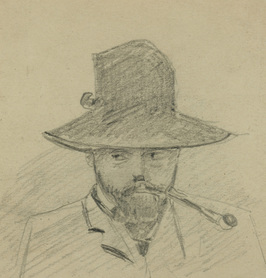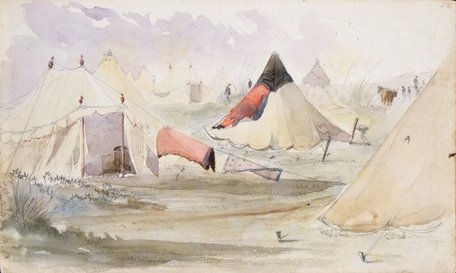SOLDIERS OF EMPIRE
Aims & Objectives |
The Project
|
Putting a face to the men who served
Where did the men who served in New Zealand come from, and where did the great majority who left the colony go to?
We can track the regiments but what do the travels of the men tell us – about the paths of mobility across the empire, about the experience that took some men from fighting in the Crimea 1854-56, to fighting in India at the time of the Rebellion (‘Mutiny’) in 1857, from serving in New South Wales or Van Diemen’s Land (Tasmania) on convict guard to sailing into Auckland and being deployed to fight against Maori opponents in Taranaki, the Waikato, Tauranga and other parts of the North Island? Exploring garrison culture
'20 men in a bell Tent is too many' - James Bodell in a muddy camp at Drury, 18631 Across the landscape of the North Island the signs of this garrison presence can be seen. It echoes the British garrison presence that was established across many parts of the world through the 19th century.
We are interested to explore this garrison culture further in its material, social, cultural and economic forms. How was it shaped as men – and their regiments – moved around the world? How did the army and navy foster cultures of empire? What impact did it have on colonial New Zealand, especially in the North Island, and how might its legacy be traced in contemporary Aotearoa-New Zealand (and the wider post-colonial world)? Evaluating Imperial war as a driver of Victorian reformIn the wake of sensational revelations of the appalling conditions suffered by soldiers in the Crimea a vigorous reform movement called for radical change in the British Army. Soldiers dying from disease and exposure, and men being led into battle by incompetent officers were captured in the stinging lines of Alfred, Lord Tennyson’s poem ‘The Charge of the Light Brigade’.
The 1857 Rebellion in India shocked the British public in other ways, making them deeply mistrustful of armed forces made up of colonial subjects. By the time of the wars in New Zealand in the 1860s debates over the best way to achieve efficiency in the armed forces, the rightful use of force, and the rationale for supporting large and expensive campaigns to defend small groups of settlers all proved highly contentious. A key issue was whether the practice of officers purchasing their commissions should continue. In 1870 the era of ‘officers and gentlemen’ came to an end with the abolition of purchase. Flogging as a form of punishment for the men in the ranks continued but was also under review. How did the expensive, protracted, and in many ways inconclusive engagements in New Zealand contribute to debates in Britain over these questions? How do we read these debates within the broader transition of Victorian Britain from a society in which merit came to count alongside, and sometimes instead of, rank? |
1. Keith Sinclair, ed., A Soldier's View of Empire. The Reminiscences of James Bodell 1831-92, London; Bodley Head, 1982, 133
Banner image: Detail of Breech loading rifle, Snider action, made by the Royal Small Arms Factory, Enfield, England, 1861. Calibre .577, Museum of New Zealand, Te Papa Tongarewa, DM000046
Favicon image: Thomas Matravers album, Sir George Grey Special Collections, 3-137-26d, Auckland Libraries
Favicon image: Thomas Matravers album, Sir George Grey Special Collections, 3-137-26d, Auckland Libraries
Copyright © 2021

